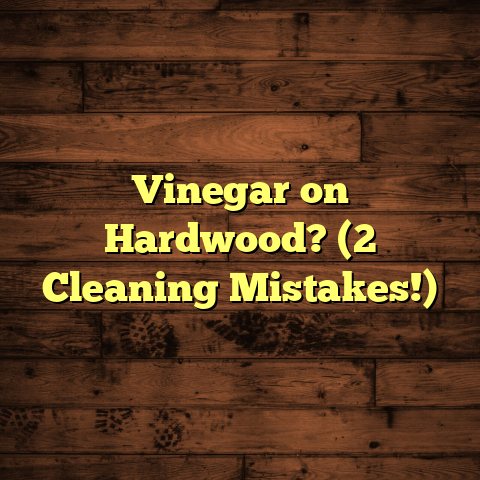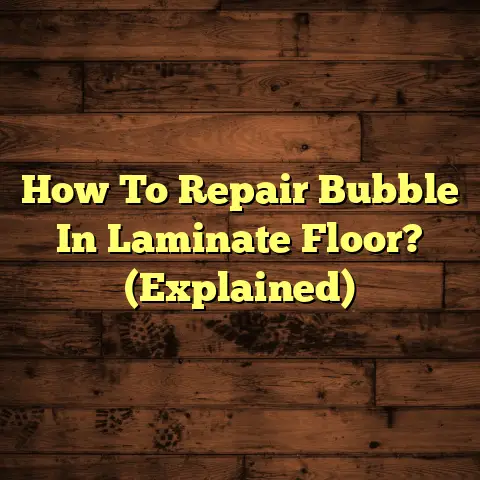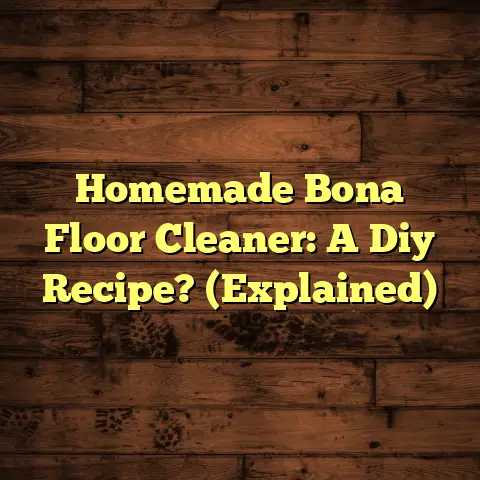How To Get Superglue Off My Floor? (2 Min Fix Now!)
I’m Mark, your friendly neighborhood flooring contractor.
Let’s face it, we’ve all been there.
You’re working on a project, maybe crafting, maybe a quick home repair, and BAM!
Superglue finds its way onto your beautiful floor.
Panic sets in, right?
Don’t worry, I’m here to tell you it’s not the end of the world, or your floor.
In fact, I’m going to show you how to get superglue off your floor, and often in just a couple of minutes!
And the best part?
We’re going to do it with eco-friendly solutions.
Because let’s be real, nobody wants harsh chemicals leaching into their home, especially when there are fantastic, natural alternatives.
The world of cleaning is changing.
We’re seeing a rise in “eco-tech,” where innovation meets environmental responsibility.
Think plant-based formulas, biodegradable packaging, and methods that minimize waste.
It’s not just a trend; it’s a necessary shift towards a healthier planet and healthier homes.
So, let’s dive in and get that superglue off your floor, the green way!
Section 1: Understanding Superglue and Its Composition
Okay, before we start attacking the problem, let’s understand our enemy.
What is superglue, anyway?
Superglue, or cyanoacrylate adhesive (that’s a mouthful, I know!), is a fast-acting, strong adhesive used in various applications, from household repairs to industrial manufacturing.
It works by rapidly polymerizing in the presence of moisture, forming long, strong chains that bind surfaces together.
Think of it like tiny little chains locking together almost instantly.
This is why it’s so effective, and also why it’s such a pain when it ends up where it shouldn’t!
Chemically, it’s composed of cyanoacrylate monomers.
These monomers are what link together to form that super-strong bond.
The speed and strength of the bond are due to the rapid polymerization process triggered by moisture in the air or on the surfaces being bonded.
Now, how does this sticky situation happen?
Well, I’ve seen it all.
From overflowing glue bottles during crafting sessions (guilty!), to drips and spills during furniture repairs, to those “oops” moments when trying to fix a broken toy.
Superglue seems to have a knack for escaping its intended target.
Section 2: Assessing the Type of Flooring
This is crucial.
You wouldn’t use the same cleaning product on a delicate silk shirt as you would on a heavy-duty work boot, right?
Same principle applies to your floors!
Here’s a quick rundown of common flooring types and how they generally react to adhesives:
- Hardwood: Can be sensitive to moisture and harsh chemicals. Superglue can sometimes damage the finish. You need to be gentle.
- Laminate: More resistant than hardwood, but still susceptible to scratching. Avoid abrasive cleaners.
- Tile: Generally quite durable and resistant to most chemicals, but grout can be porous and absorb the glue.
- Vinyl: Relatively resilient, but some solvents can cause discoloration.
- Concrete: Porous, so the glue can really dig in. You might need a bit more elbow grease.
Not sure what type of flooring you have?
Here are a few quick tips:
- Look for seams: Laminate and vinyl often have visible seams.
- Check the edges: Hardwood will have a solid wood core.
- Tap it: Tile sounds different than wood or vinyl.
- Ask the previous owner or builder: Sometimes the easiest solution is just to ask!
Knowing your floor is half the battle.
Once you know what you’re working with, you can choose the safest and most effective removal method.
Section 3: Quick Eco-Tech Solutions for Superglue Removal
Alright, let’s get to the good stuff!
Here are my go-to eco-friendly methods for tackling superglue spills, aiming for that two-minute fix (results may vary, depending on the size and age of the spill, of course!).
Method 1: Using Natural Oils (Olive Oil, Coconut Oil)
This is my personal favorite for hardwood and laminate.
Oil works by penetrating the glue and breaking down its bond with the floor.
It’s gentle, non-toxic, and smells great!
- Step 1: Grab your oil of choice (olive or coconut work great).
- Step 2: Apply a generous amount of oil directly onto the superglue. Make sure it’s fully saturated.
- Step 3: Let it sit for a minute or two. This gives the oil time to work its magic.
- Step 4: Gently wipe away the softened glue with a soft cloth. You might need to repeat this a couple of times.
- Step 5: Clean the area with a damp cloth to remove any residual oil.
Method 2: Vinegar and Baking Soda Mixture as a Gentle Abrasive
This is a great option for tile and more durable surfaces.
The mild acidity of vinegar combined with the gentle abrasiveness of baking soda helps to lift the glue without causing damage.
- Step 1: Mix equal parts vinegar and baking soda to form a paste. (Think toothpaste consistency).
- Step 2: Apply the paste to the superglue stain.
- Step 3: Let it sit for a minute.
- Step 4: Gently scrub the area with a soft cloth or sponge. Avoid using anything too abrasive that could scratch the floor.
- Step 5: Rinse with water and wipe dry.
Method 3: Rubbing Alcohol or Nail Polish Remover Alternatives
Now, I know what you’re thinking: “Rubbing alcohol isn’t exactly ‘eco-friendly!'”
And you’re right, traditional rubbing alcohol isn’t.
However, there are now plant-based rubbing alcohol alternatives available!
Look for those made from fermented corn or other sustainable sources.
Similarly, you can find nail polish removers that are acetone-free and made with natural ingredients.
These options are less harsh on the environment and your home.
- Step 1: Soak a cotton ball or soft cloth with your eco-friendly rubbing alcohol or nail polish remover alternative.
- Step 2: Gently dab the superglue stain. Avoid rubbing vigorously, as this could spread the glue.
- Step 3: Let it sit for a few seconds to soften the glue.
- Step 4: Wipe away the softened glue with a clean cloth.
- Step 5: Rinse with water and wipe dry.
Section 4: Step-by-Step Guide to Removing Superglue
Okay, let’s put it all together with a clear, concise step-by-step guide for each method.
I’m a visual person, so I always appreciate diagrams.
I’ll try to paint a picture with words!
(Method 1: Natural Oils)
- Gather Supplies: Olive oil or coconut oil, soft cloth, damp cloth.
- Apply Oil: Generously apply oil directly onto the superglue stain.
- Wait: Let the oil sit for 1-2 minutes to soften the glue.
- Wipe: Gently wipe away the softened glue with a soft cloth. Repeat if necessary.
- Clean: Clean the area with a damp cloth to remove any residual oil.
- Dry: Dry the area with a clean cloth.
(Method 2: Vinegar and Baking Soda)
- Gather Supplies: White vinegar, baking soda, soft cloth or sponge, water.
- Make Paste: Mix equal parts vinegar and baking soda to form a paste.
- Apply Paste: Apply the paste to the superglue stain.
- Wait: Let it sit for 1 minute.
- Scrub: Gently scrub the area with a soft cloth or sponge.
- Rinse: Rinse with water.
- Dry: Wipe dry with a clean cloth.
(Method 3: Rubbing Alcohol/Nail Polish Remover Alternative)
- Gather Supplies: Eco-friendly rubbing alcohol or nail polish remover alternative, cotton ball or soft cloth, water.
- Apply Solution: Soak a cotton ball or cloth with the solution.
- Dab: Gently dab the superglue stain.
- Wait: Let it sit for a few seconds.
- Wipe: Wipe away the softened glue with a clean cloth.
- Rinse: Rinse with water.
- Dry: Wipe dry with a clean cloth.
Remember, always test any cleaning solution in an inconspicuous area first to ensure it doesn’t damage your flooring.
Prevention is always better than cure, right?
Section 5: Preventing Future Superglue Mishaps
So, you’ve conquered the superglue monster this time.
But how do you avoid a repeat performance?
Here are a few tips to keep your floors glue-free:
- Use Protective Coverings: When working with superglue, always cover your work surface with a drop cloth, newspaper, or cardboard.
- Designated Crafting Area: If you’re a frequent crafter, consider setting up a designated crafting area with a durable, easy-to-clean surface.
- Be Mindful: Pay attention to what you’re doing! Avoid distractions when working with adhesives.
- Use the Right Applicator: Consider using a precision applicator for superglue to minimize drips and spills.
- Clean Up Immediately: If a spill does occur, clean it up immediately before the glue has a chance to dry.
I’ve learned this the hard way, trust me.
I was building a model airplane with my son, and I got distracted by a phone call.
Next thing I knew, there was a big blob of superglue on my brand-new hardwood floor!
Luckily, I knew the oil trick, and I was able to save the day.
But it was a good reminder to always be mindful when working with adhesives.
Section 6: Eco-Friendly Cleaning Practices Beyond Superglue
Okay, we’ve talked about superglue, but let’s zoom out and talk about eco-friendly cleaning in general.
It’s not just about dealing with accidents; it’s about creating a healthier, more sustainable home.
Here are a few simple swaps you can make:
- Replace chemical cleaners with natural alternatives: Vinegar, baking soda, lemon juice, and essential oils can be used to clean almost anything.
- Use reusable cleaning cloths: Ditch the paper towels and switch to microfiber cloths or old t-shirts.
- Make your own cleaning solutions: There are tons of recipes online for homemade cleaners using simple ingredients.
- Choose eco-friendly cleaning products: Look for products with plant-based formulas, biodegradable packaging, and certifications like EcoLogo or Green Seal.
- Reduce your consumption of single-use plastics: Refill your cleaning product bottles instead of buying new ones.
I’ve been slowly transitioning to more eco-friendly cleaning practices in my own home, and I’ve been amazed at how effective and affordable it is.
It’s also incredibly rewarding to know that I’m doing my part to protect the environment.
Every small change makes a difference.
Switching to reusable cloths, making my own all-purpose cleaner, and choosing eco-friendly dish soap have all had a positive impact.
And it feels good!
Conclusion
So, there you have it!
A comprehensive guide to getting superglue off your floor using eco-friendly methods.
We’ve covered everything from understanding the composition of superglue to preventing future mishaps to embracing eco-friendly cleaning practices in general.
Remember, cleaning up spills doesn’t have to involve harsh chemicals that are harmful to your health and the environment.
There are plenty of effective, natural alternatives that are just as good, if not better.
By embracing eco-tech solutions, you can create a cleaner, healthier, and more sustainable home for yourself and your family.
And that’s something we can all feel good about.
Call to Action
Now, I want to hear from you!
Have you ever had a superglue disaster on your floor?
What methods have you tried to remove it?
Do you have any favorite eco-friendly cleaning hacks that you’d like to share?
Let me know in the comments below!
And if you’re interested in learning more about eco-friendly living and cleaning solutions, be sure to check out my other articles and videos.
Let’s work together to create a cleaner, greener world, one superglue spill at a time!





